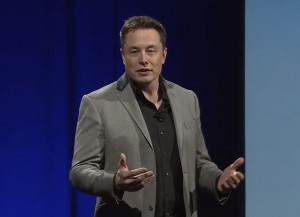
Tesla CEO Elon Musk guaranteed the company's 100MW storage battery in South Australia will be ready in 100 days or it's free.
Elon Musk continues to add to his reputation as a gambling man. Tesla’s just won the contract to produce a 100MW hour lithium ion, grid-style storage system for South Australia.
Tesla’s founder and CEO told officials that the company would build it in 100 days or it would be free: a $50 million guarantee.
“There will be a lot of people that will look at this -‘Did they get it done within 100 days? Did it work?'” Musk told reporters in South Australia’s capital city of Adelaide. “We are going to make sure it does.”
The battery will be built on a wind farm operated by France’s Neoen — parts of which are still under construction, Reuters reports. Once completed, it will be the largest lithium ion storage battery on earth, surpassing the 80 megawatt-hour battery in California. It also uses Tesla batteries.
(A good week gone bad for Tesla. To see why, Click Here.)
The project is vital to the state for two reasons. First, it suffers through terrible storms that can often cause outages that a storage grid could offset. Additionally, South Australia shut down many of its coal-burning energy plants choosing to rely on wind and solar power.
When the winds are low, the region suffers outages to due to inadequate storage capability. This system is designed to light up 30,000 homes in the event of a blackout. Tesla had to outbid 12 companies from 10 countries to secure the contract.
As part of his pitch, Musk has been making the 100-days-or-else offer in tweets since March. “Tesla will get the system installed and working 100 days from contract signature or it is free. That serious enough for you?” he tweeted on March 9.
The contract will put a positive spin on Musk’s week. After months of watching the company’s stock rise, making it the most valuable U.S. automaker, it took a bit of a hit after he announced plans to kick off Model 3 production this month.
(Click Here for more about the most recent Model S IIHS crash rating.)
Traders returned from the long Fourth of July holiday and the stock fell 7% on Wednesday and, by midday Thursday it dipped nearly another 5%. At around $310 per share by mid-afternoon, TSLA was not only off sharply from the record $383.45 set on June 23, but with a market capitalization of just under $51 billion, the value of Tesla had slipped behind that of General Motors for the first time in nearly three months.
The drop was precipitated by news that the maker’s Model S failed to secure the highest safety rating possible from the Insurance Institute for Highway Safety. The big Model S fared well in all but one test run by the IIHS, but that one is considered critical by the insurance industry’s auto safety arm, as the Small Overlap test is meant to replicate frequent highway incidents – such as when two cars clip one another traveling in opposite directions, or when a vehicle’s corner hits a telephone pole.
Surprisingly, the issue wasn’t the actual structure of the Tesla sedan, the IIHS noted. “The main problem with the performance of the Model S was that the safety belt let the dummy’s torso move too far forward, allowing the dummy’s head to strike the steering wheel hard through the airbag.”
The IIHS wound up testing two versions of the Model S, reflecting an update to the seatbelt system made in January. But, in the second test, there was greater intrusion into the driver’s space as a result of the crash.
(Tesla confirms plans to launch Model 3 sales, production this Friday. Click Here for more on that story.)
The group combined the results of the two tests and the Tesla Model S earned an “Acceptable” rating in the Small Overlap test. As a result, it fell short of what was needed to get the overall Top Safety Pick+ ratings The IIHS also gave a “Poor” rating to the headlights on the Model S.
